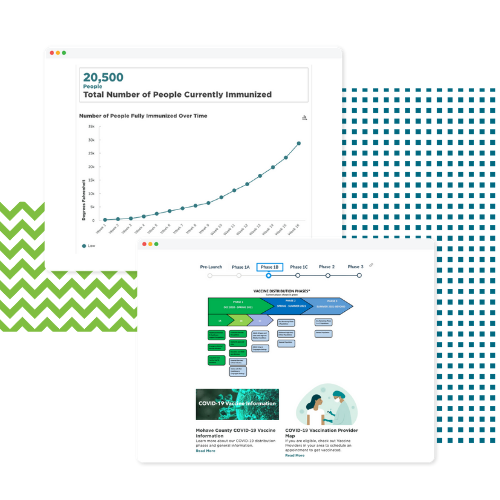Fund Health Equity and Target Grants by Visualizing Community Data
Voices for Healthy Kids®, an initiative of the American Heart Association, works with mySidewalk to leverage community data in its grantmaking process. Voices for Healthy Kids accomplishes its mission to improve or create equitable policies that make the places kids live, learn, and play healthier by supporting public policy advocates across the nation through grantmaking. Engaging coalitions, mobilizing community members, and developing evidence-based messaging and campaign materials are all central to the team’s work.
Across all of these activities, health equity is a foundational value and goal. For Voices for Healthy Kids, “equity is not optional. It’s our mission.” Ensuring that funding is awarded to the communities with greatest need and to organizations with diverse representation are key considerations for the team. Over the past year, Voices for Healthy Kids collaborated with mySidewalk to leverage social determinants of health data to build an equity-focused, data-driven grant review process.
Siloed data obscures where the need is greatest
With $3-5 million of grant funding to allocate each year, Voices for Healthy Kids operationalizes equity in its grantmaking strategy by prioritizing policy interventions that focus on areas where children’s health needs are most significant. This is a shift away from focusing on improving health for all children to one that explicitly centers on communities in greatest need. As Phil Noyes, Policy Research Manager, explained, “we want to have a way to look at and think about our grantmaking being influenced by locations that are most impacted by health inequities or racism.”
Factoring community need into grant applications was not a new consideration for Phil and his team. In previous years, Voices for Healthy Kids asked applicants to share a population impact statement using data to describe the communities that would benefit from the funded policy campaigns. Voices for Healthy Kids intended for population impact statements to provide applicants with an opportunity to describe intended policy outcomes for communities of focus by drawing upon demographic and children’s health data. However, there was a pitfall to this approach: grantees struggled to find detailed, local data and, as a result, grant reviewers weren’t able to compare community needs across applications.
The challenge with Voices for Healthy Kids’ population impact statements is a common one in philanthropic settings. For grant applicants that are already resource strapped, accessing community data can be a challenge. Weaving a comprehensive data story about a community’s social determinants of health requires the time and capacity to stitch together data from numerous sources. The challenges in accessing community-level data can also undermine the sustainability of small, grassroots nonprofits that are led by and serve Black/African American, Hispanic/Latino/a, Native American, Alaskan Native and Pacific Islander or from families who have low income. Consequently, where data should be a tool for promoting equity, difficulty accessing and sharing it can exclude the very organizations and communities that should be prioritized in equity-centered grantmaking.
In Phil’s words, the Voices for Healthy Kids team needed the tools “to operationalize our equity commitment by infusing equity considerations throughout the grant review process.” More accessible, local, and comprehensive community data was a key component to this strategy.
Community data reveals new opportunities across the map
The Voices for Healthy Kids team decided it was time to flip the script. Instead of placing the burden of accessing community data on applicants, Voices for Healthy Kids would take on this task using mySidewalk’s data library and visualization platform, Chart. Through mySidewalk, the Voices for Healthy Kids team can access more than 45 sources of social determinant of health data, including indicators on race/ethnicity from the American Community Survey, food access from the United States Department of Agriculture, and obesity rates from the Centers for Disease Control and Prevention.
From these data, Phil and the Voices for Healthy Kids team selected four indicators — racial/ethnic composition of communities, child poverty, food insecurity, and child obesity rates — to summarize children's health in any community. When they receive a new application, they run a report on the area of focus in Chart, visualizing and mapping each of the indicators. These indicators are combined with a population impact score and organizational equity score. Together, these scores provide the grant review team with insight into the extent to which each application supports organizational diversity and health equity. Scores and reports are also shared with applicants to provide them with an opportunity to respond.
The reports allow for an integration of equity throughout the grant review process to drive informed decision-making about where to fund applications. Rather than solely relying on existing relationships, access to community data in mySidewalk provides a comprehensive overview of community health across the country, revealing priority areas for funding based on Voices for Healthy Kids’ specific criteria. The applicant-specific reports and population impact scores allow the review committees to identify applications that will support communities with the greatest need.
Outcomes
Using community data to transform the grantmaking process contributes to several key outcomes. Shannon Melluzzo, the Voices for Healthy Kids Manager of Advocacy Grants, oversees the application and review process and attributes Phil’s work with community data from mySidewalk to “changing who and where we fund to align with our equity goals.” In the last grant cycle, Voices for Healthy Kids used community data to identify 13 high-priority states that were specified in the application and marketing materials. After conducting targeted outreach in these high-priority states, Voices for Healthy Kids received more applications from priority states than ever before.
Accessing and visualizing community data are both key components to Voices for Healthy Kids’ equity-centered grantmaking process. Actionable community data is hard to come by. “Without access to data, this would be a much larger project. It would be far more complex, really laborious to do the county and city scoring and compare community need” Phil said.
Voices for Healthy Kids uses mySidewalk to search through numerous data sources in one place and to create a uniform way to visualize data for different communities. Plus, the ability to share reports through a single URL makes them accessible and provides transparency into Voices for Healthy Kids’ decision-making process. “Transparency is so important,” Phil explained. “Sharing reports and scores easily gives us a way to have a numeric score so that we can talk about these issues and support decision making in a way that is transparent with review committees, the applicants, and their communities.”
Next steps: leveraging the power of local data
For the Voices for Healthy Kids team, this is only the beginning. They will continue to build processes that ensure equity is not a single question or consideration, but a lens that frames all aspects of the grantmaking process.
Developing a more refined index with the mySidewalk team to summarize community data for each application is one next step for Voices for Healthy Kids. Equally important is identifying meaningful ways for applicants to respond to the data in community impact reports.
While data is one tool to support grantmaking in service of health equity, Voices for Healthy Kids is also committed to creating more space for applicants to share their lived experience alongside the data. “We really want to open a dialogue,” said Shannon, “so that applicants can tell us about their experience and other data points that demonstrate the need for working in their communities.” As the Voices for Healthy Kids team continues to learn and explore approaches for more equitable grantmaking, community data, like what is available in mySidewalk, will continue to be a critical component to telling the full story of children’s health.™
Share this
You May Also Like
These Related Stories

Data's mission-critical role in overcoming Substance Use Disorders

mySidewalk's COVID-19 Vaccine Tracker



No Comments Yet
Let us know what you think